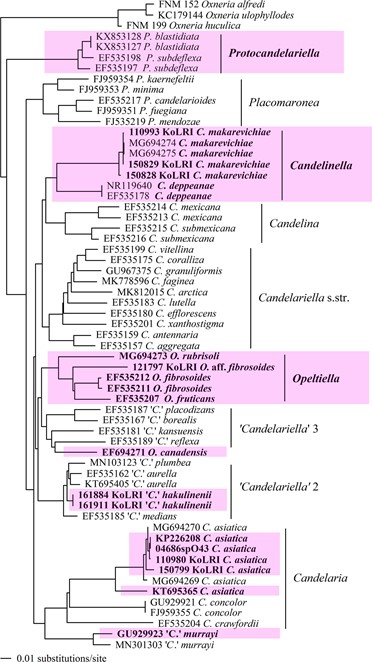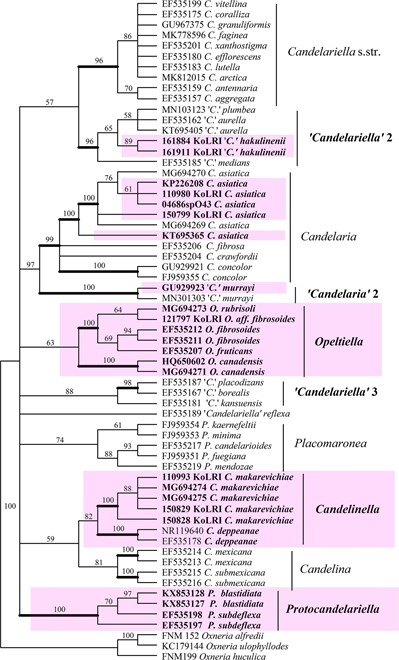Opeltiella S. Y. Kondr., gen. nov.
MycoBank number: MB 836763; Index Fungorum number: IF 836763; Facesoffungi number: FoF;
Similar to Candelaria, but differs in having 8-spored asci as well as in the lack of lower cortical layer and true rhizines.
Type species: Opeltiella fruticans (Poelt et Oberw.) S. Y. Kondr.
Thallus areolate to subsquamulose or subfoliose, adnate to ascending or more or less erect (in O. fruticans), irregularly incised. Upper surface yellow, matt, smooth; soredia and isidia lacking or with sorediate lower surface (in O. fruticans) or thalline areoles breaks and ultimately dissolves into soredia. Lower surface white, ecorticate, arachnoid to tomentose with a thick mat of hyphal strands, true rhizines lacking. Apothecia lecanorine, disc more or less flat, thalline margin persistent; asci 8-spored; ascospores simple to 1-septate, narrowly ellipsoid; conidia ellipsoid, 2.0−3.5 × 1.5 µm.
Chemistry: calycin (major substance), pulvinic and vulpinic acids, and pulvinic acid lactone.
Etymology: The name Opeltiella, similarly to the genus name Opeltia S. Y. Kondr. et L. Lőkös of the subfamily Caloplacoideae of the Teloschistaceae, originates from an anagram of the generic name Poeltia Grolle (Gymnomitriaceae, Marchantiophyta) dedicated to Josef Poelt (1924–1995), one of the greatest lichenologist in the history of the science, and the co-author of the type species of this genus.
Distribution and ecology: The genus hitherto includes four species, two of which are known from South America, as well as one species from Eastern Asia and one more from North America. Four species are confirmed as being members of the Opeltiella branch from the multigene phylogeny. However, one species, i.e. Opeltiella canadensis, may be included in another genus in the future. Species are known from dead shrubs and cacti sometimes together with Teloschistes hosseusianus Gyelnik in dry pasture land at high altitude (ca 2,200 m a.s.l.), as well as on bark of deciduous trees and from pine tree (Pinus armandi) in lowlands and in coastal zone.
Taxonomic notes: Our data of multigene phylogeny confirm that the genus Opeltiella, which is proposed here for the ‘Candelaria’ fruticans group, as a separate robust monophyletic branch is positioned separately / distantly from Candelaria s. str., including only polyspored species with well-developed lower cortical layer and with true rhizines (Fig. 2). In our nrITS phylogeny Opeltiella was positioned in sister position to the ‘Candelariella’ placodizans group (Fig. 1).

Fig. 1. Position of Candelinella, Opeltiella and Protocandelariella species in the phylogenetic tree of the Candelariaceae based on nrITS phylogeny

Fig. 2. Position of Candelinella, Opeltiella and Protocandelariella species in the phylogenetic tree of the Candelariaceae based on combined multigene phylogeny
Species
